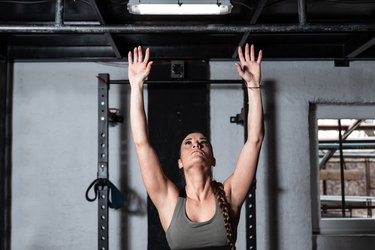
Anemia is one of the health conditions that can affect your hemoglobin levels and ability to exercise. Here's what you need to know about anemia and the exercise precautions you might need to take if you have it.
Read more: Iron Deficiency & Anemia in Men
Video of the Day
Video of the Day
What Is Anemia?
The National Institutes of Health (NIH) explains that hemoglobin is an iron-rich protein in your blood that helps your red blood cells carry oxygen from your lungs to the rest of your body. Anemia is a condition that results when your blood doesn't have enough hemoglobin or red blood cells. As a result, your body doesn't get as much oxygen-rich blood as it needs.
According to the Mayo Clinic, anemia can occur if your body cannot make enough red blood cells or if it destroys the red blood cells it creates. You can also get anemia if you lose red blood cells (through bleeding) faster than your body is able to replace them. The NIH notes that anemia can also be a sign of a more serious health condition, like cancer, kidney disease or autoimmune diseases.
The Mayo Clinic lists iron deficiency anemia, sickle cell anemia, thalassemia and vitamin deficiency anemia as some of the different types of anemia. Anemia can vary from mild to severe and it can be temporary or a long- term condition.
Anemia is in fact a fairly common condition; an April 2015 study published in the Gastroenterology and Hepatology journal estimates that one-fourth of the world has anemia and that iron deficiency anemia is the most common form of the condition.
The NIH states that some groups of people are at a higher risk of developing anemia. These groups include people who donate blood often, pregnant and menstruating women, people who don't get enough iron or vitamins through their diet and. Those who are on certain medications or undergoing certain treatments, like chemotherapy may be at increased risk.
Anemia and Exercise Precautions
So, what's the connection between exercise and your hemoglobin levels? According to the Mayo Clinic, the symptoms of anemia include dizziness, fatigue, paleness, headaches, cold skin and hands, chest pain and irregular heartbeats. A July 2013 study published in the journal Cold Spring Harbor Perspectives in Medicine notes that people who have anemia may also experience exercise-associated dyspnea (shortness of breath) while they exercise.
These symptoms can make it difficult for you to exercise with low hemoglobin levels. The American Academy of Family Physicians says that the lack of oxygen in your body reduces your energy levels and also causes your heart to work harder to pump blood. The NIH notes that anemia is in fact sometimes also referred to as low blood, iron-poor blood and tired blood.
You should consult your doctor to ensure that your condition is properly diagnosed. Your doctor can also guide you about the appropriate treatment for anemia and any exercise precautions you might need to take. The treatment will depend on the type of anemia you have and its underlying causes.
For instance, the American Society of Hematology states that most cases of iron deficiency anemia can be treated by including more iron-rich foods in your diet in your diet and taking medicinal iron.
If your doctor clears you for exercise, it can in fact help improve your condition. Exercise spurs the growth of red blood cells, which can help reduce anemia.
- Mayo Clinic: “Low Hemoglobin Count”
- National Institutes of Health: “Anemia”
- Mayo Clinic: “Anemia”
- Gastroenterology and Hepatology: “Management of Iron Deficiency Anemia”
- Cold Spring Harbor Perspectives in Medicine: “Iron Deficiency Anemia: A Common and Curable Disease”
- American Academy of Family Physicians: “Anemia”
- American Society of Hematology: “Iron Deficiency Anemia”
- Dialysis Patient Citizens Education Center: “What You Can Do to Manage Your Anemia”
Is this an emergency? If you are experiencing serious medical symptoms, please see the National Library of Medicine’s list of signs you need emergency medical attention or call 911.